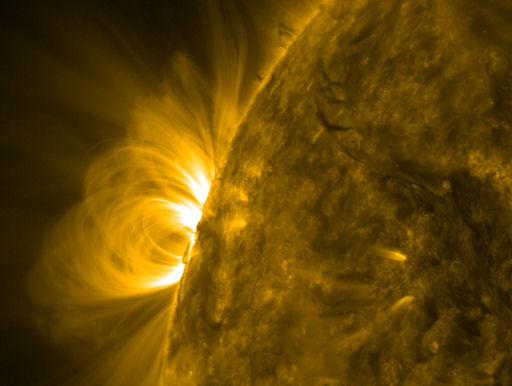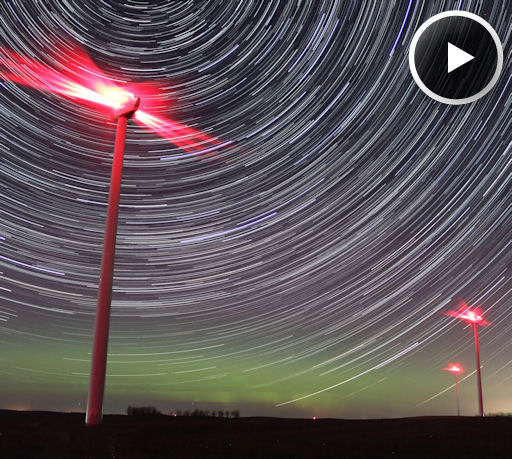IS IT SNOWING MICROBES ON ENCELADUS? As NASA's Cassini spacecraft completes its deepest-ever pass through the plumes of Enceladus, researchers are wondering if it might be snowing microbes there. The idea is not so far-fetched as evidence mounts for a "uniquely accessible" habitable zone on Saturn's icy moon. [full story]
RETURN OF THE SUNSPOT: Sunspot AR1429, the source of many strong flares and geomagnetic storms earlier this month, is about to re-appear following a two-week trip around the backside of the sun. Magnetic loops towering over the sun's NE limb herald the sunspot's approach:
Earlier today, NASA's Solar Dynamics Observatory photographed plumes of plasma rising and falling over the limb: movie. Moreover, a pair of solar flares (C5- and C7-class) in the sunspot's towering magnetic canopy caused waves of ionization to ripple through the high atmosphere over Europe. These events suggest the region is still active. Stay tuned. Solar flare alerts: text, phone.
NORTHERN LIGHTS OVER NEBRASKA: A solar wind stream is buffeting Earth's magnetic field, causing magnetic unrest and auroras at high latitudes. On March 27th, faint Northern Lights descended all the way south to Nebraska. Click to view a movie of the display, photographed by Chris Allington of Crofton, NE:
"I certainly didn't expect this tonight, but the plots were interesting enough to get me out and investigate the northern sky with the camera," says Allington. "Suprisingly, around 9:30pm local time I could see the color of the aurora on my camera so I decided to head to a wind farm near my house. The display got much more vibrant and lasted nearly 4 hours from 10pm to 2am. It's not often that auroras are hardly in the forecast and we see them as far south as NEBRASKA! "
The cause of the display was the interplanetary magnetic field (IMF), which tipped south and opened a crack in Earth's magnetosphere. Solar wind poured in to fuel the light. More high-latitude auroras are possible tonight: NOAA forecasters estimate a 30% chance of polar geomagnetic activity as the solar wind continues to blow. Aurora alerts: text, phone.

![]()
Solar wind
speed: 327.4 km/sec
density: 0.8 protons/cm3
explanation | more data
Updated: Today at 1635 UT
![]()
X-ray Solar Flares
6-hr max: C5 1321 UT Mar29
24-hr: C7 0953 UT Mar29
explanation | more data
Updated: Today at: 1600 UT
![]()
![]()
![]()
Daily Sun: 29 Mar 12
![]()
![]()
None of these sunspots pose a threat for strong solar flares. Credit: SDO/HMI
![]()
![]()
![]()
Sunspot number: 70
What is the sunspot number?
Updated 28 Mar 2012
Spotless Days
Current Stretch: 0 days
2012 total: 0 days (0%)
2011 total: 2 days (<1%)
2010 total: 51 days (14%)
2009 total: 260 days (71%)
Since 2004: 821 days
Typical Solar Min: 486 days
Updated 28 Mar 2012
The Radio Sun
10.7 cm flux: 107 sfu
explanation | more data
Updated 28 Mar 2012
![]()
![]()
![]()
Current Auroral Oval:
![]()
Switch to: Europe, USA, New Zealand, Antarctica
Credit: NOAA/POES
![]()
![]()
![]()
Planetary K-index
Now: Kp= 1 quiet
24-hr max: Kp= 2 quiet
explanation | more data
![]()
Interplanetary Mag. Field
Btotal: 3.4 nT
Bz: 1.2 nT south
explanation | more data
Updated: Today at 1637 UT
![]()
![]()
![]()
Coronal Holes: 29 Mar 12
![]()
![]()
There are no large coronal holes on the Earthside of the sun. Credit: SDO/AIA.






